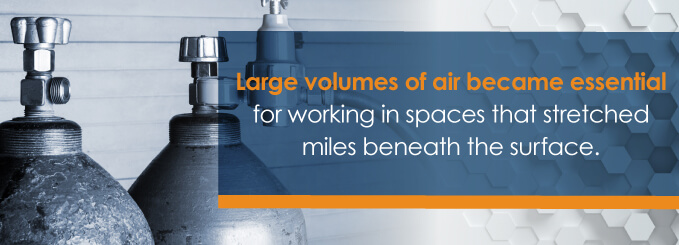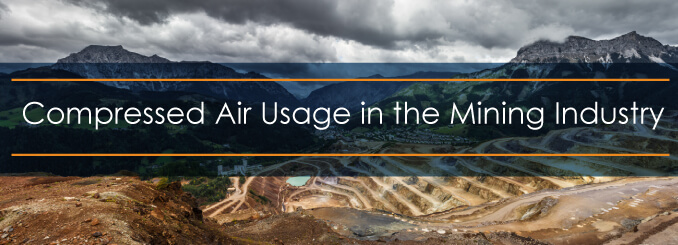
Compressed Air Usage in the Mining Industry
Working deep underground, mining for the precious natural resources of the Earth can present fierce challenges for workers even with the advancements of modern technology. With the dawn of the first motorized air compressors in the early 1800s, the mining industry has greatly benefited from the improvement of compressed air systems, which have provided value to workers and the development of more efficient methods for resource extraction. Because of the demands and dangers of working underground, or in areas where water can pose a threat, compressed air has been an invaluable source of both energy and safety equipment for the hard-to-reach places were minerals and fossil fuels reside.
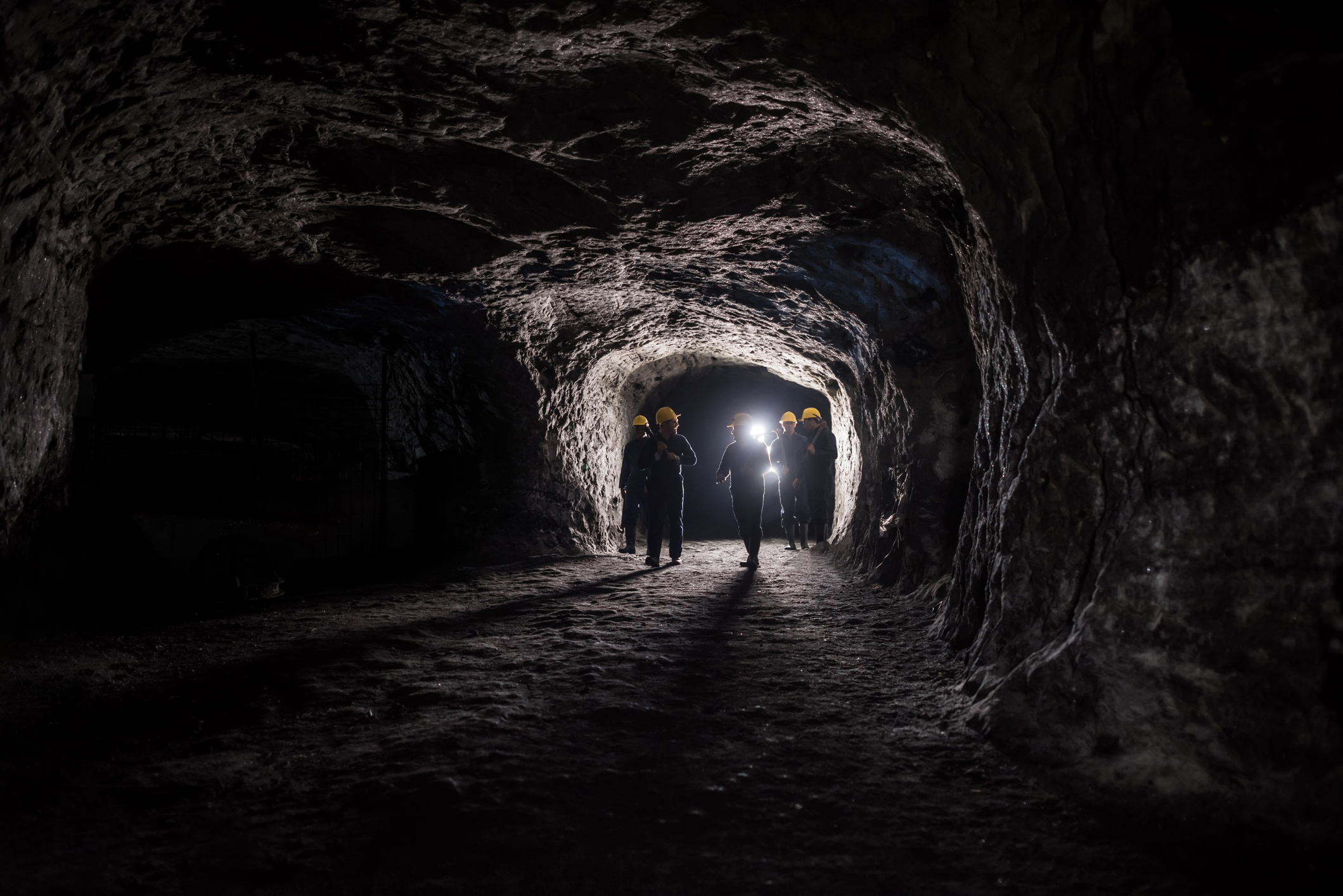
The English inventor, George Medhurst, created the first motorized air compressor system useful for the mining industry in 1799. By 1852, Isambard K. Brunel expanded upon this use of compressed air with a pressurized caisson, or water tight chamber used in underwater construction. This helped prevent water and mud from entering workspaces when working in waterlogged sites for the construction of bridges. Following these early advancements, Thomas Cochrane, another English engineer, invented a better compressed air rock drill in 1857, that allowed workers to tunnel.
While Cochrane’s invention was successful, this type of drilling process was first suggested in 1844, and it was nicknamed the “wind hammer” by another English engineer who saw that traditional steam driven drills were not very reliable. These successes in compressed air-driven machinery promoted years of research and development for the betterment of mining technology. Compressed air also aided in the ventilation of mines early on because it provided a breathable air that was released by the exhaust of the compressed air drills, which also helped cool the atmosphere.
| Contact Us | Learn More | Find a Dealer Near You |
The Continued Growth of Compressed Air in the Mining Industry
As mining grew and the demand for more consumable natural resources continued, improving ventilation to mining tunnels that expanded further into the earth became increasingly common. Large volumes of air became essential for working in spaces that stretched miles beneath the surface. In addition, air compressors also became a great way for transmitting energy underground.
One of the most famous uses of compressed air in mining comes from the creation of the Mt. Cenis tunnel, which stirred publicity in the newspapers and scientific journals of the late 1800s. With a growing focus on how it could be better utilized, Austrian engineer Viktor Popp helped develop a compressed air network that could provide energy to a variety of industries. His 1,500 kilowatt compressor plant soon expanded to more than 18,000 kilowatts by 1891.
The popularity of compressed air systems grew exponentially from there, and many engineers hurried to make improvements and file patents for new machines and tools. The development of electric and pneumatic energy sources from compressed air systems continued to boom over the remainder of the 20th Century, cementing itself as the valuable industrial resource we see today.
In the modern age, a range of different, complex compressor systems are now available, specifically designed for tasks both big and small. Designs are also varying, including portable, vehicle mounted and larger industrial compressor types. Air compressors used in the mining industry differ depending on their purpose and the demand requirements needed for the task.
In this short guide, we will take a look at some of the common uses and considerations for selecting the compressor system that will most benefit your mining operation. Selecting the right compressor to meet your needs can help increase productivity and serve to lower energy costs.
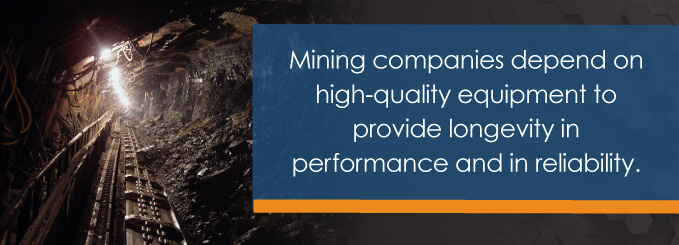
Compressed Air Usage in Mining — The Basics
Mining is an expansive industry that stretches across the world, with a focus on a vast number of different natural resources. From the coal mining operations of the American Appalachians to the diamond-rich mines of South Africa, extracting the planet’s most valuable, useful and beautiful natural resources comes with a level of inherent risk, both financially and in worker safety.
Underground mines can stretch for miles below Earth’s surface, which poses unique challenges when trying to achieve efficient resource extraction and safety for your work crew. Modern mining processes rely on enhancements in safety equipment, as well as consideration for reducing negative impacts on the environment.
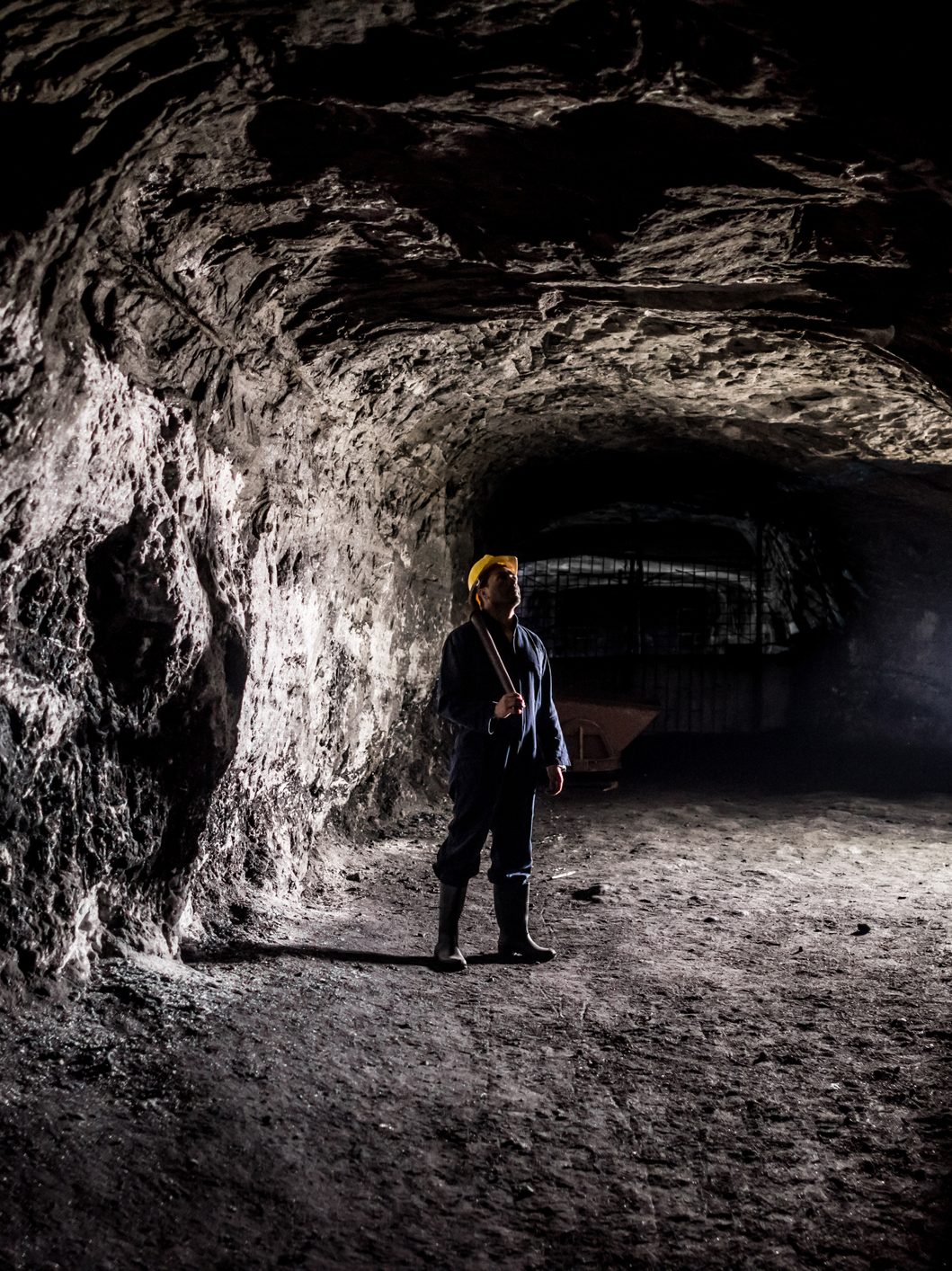
Mining companies depend on high-quality equipment to provide longevity in performance and in reliability. Through the use of industrial air compressor systems, electric and pneumatic tools are used in drilling, material handling, transportation, mineral extraction and complex ventilation systems. Selecting a compressor that is built to withstand the wear and tear of mining, as well as stand up to the demands of continued use in the long term is important for your bottom line. Depending on the resources desired, compressed air needs may vary in mining operations.
While underground compressors may be needed for some mining processes, which can reduce the need for complex piping systems and lower the amount of leakage, it is more common to find compressors at the surface, which reticulate compressed air through the use of steel pipes.
Compressed air is used as an energy source frequently in mining because of its flexibility over the use of diesel and electric power in locations underground. However, low capacity applications such as drilling short holes, pumping and pneumatic tools such as wrenches and saws are more commonly used with compressed air systems at sites. In some cases, compressed air may be used in ventilation systems. Ventilation is important in all situations, especially ones where methane can build since it can be easily ignited by a spark of static electricity.
It is imperative that all compressed air systems or equipment used in these situations are specifically designed to prevent static electricity build-up and are grounded properly. This includes hoses, which can be made of fire retardant and anti-static materials. In addition to being more restrictive in terms of availability, underground compressors can also become fire hazards, which is why surface compressors are more often used.
Common Mining Applications for Compressed Air
Mining applications where compressed air is especially useful include:
- Pneumatic Tools – Compressed air is an excellent source of energy for power tools such as drills, wrenches, hack saws and other vital mining equipment that needs to be used in the deep underground stretches of the mines.
- Blasting – Compressed air systems offer safer mediums for use in blasting operations. High velocity compressed air streams can be vital in some mining situations.
- Material handling – Materials like coal dust can be better handled when compressed air is mixed, allowing for fluidization. In addition, compressed air can be used in conveying material in mining as well.
- Cleaning – Compressed air can also be used for purging unwanted particles from filters and other spaces amid the dirt and dust of the mining operation. It is a clean source of air and can be used effectively without the need for additional cleaning materials. This can help extend the longevity of critical mining equipment and reduce any downtime needed for maintenance.
- Ventilation Systems – As mentioned above, compressed air has a long history of providing ventilation to increasingly deep mine tunnels. It is a safe and breathable source of air that can be used in hazardous mining environments. In addition, displacement blowers can also utilize compressed air systems for ventilation. In coal mining for example, displacement blowers are used to provide the needed air ventilation to mining sites.
- Methane Gas Extraction – Methane gas build up in a mine can be lethal. The risk for a static electric spark igniting methane as well as actually breathing the gas are both dangers for miners. Compressed air systems properly fitted and designed for use in dangerous environments can help extract the gas through the use of blowers and vacuum pumps for coal mining operations.
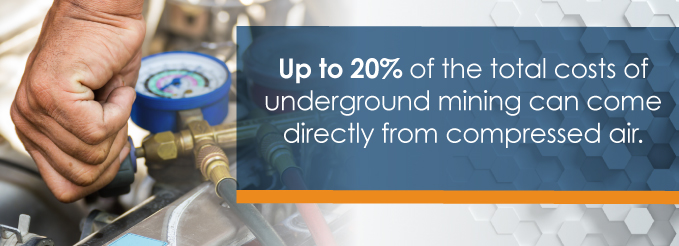
Energy Efficiency in Compressed Air Systems Used in Mining
While compressed air is indeed a valuable resource in mining, it can also be costly, especially if leaks are not addressed, and proper maintenance is not conducted routinely on the system. Up to 20 percent of the total costs of underground mining can come directly from compressed air. In addition, nearly 20 to 40 percent of all energy costs for compressed mining can be from compressed air usage.
The costs of compressed air can be high if the system is not running efficiently because of the amount of electrical horsepower needed just to generate one HP of compressed air. On average, anywhere between seven to eight HP of electrical power to produce just one HP of compressed air power. Additionally, only about 19 percent of the total power used in a compressed air system is converted into compressed air flow. The other 81 percent is lost as heat.
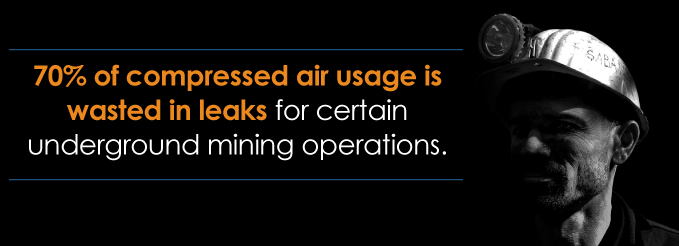
If you combine that with any leaks in your mining operation, the costs could rise substantially, which is why system efficiency is so important in reducing your overall expenditures. Researchers found that up to 70 percent of compressed air usage is wasted in leaks for certain underground mining operations. In some cases, a single half-inch diameter leak could contribute to annual loss of more than $12,800 for a one shift operation. In addition, the numbers could range near $48,000 for a three-shift operation. Even a single, tiny leak in an entire system that measures 1/16 of an inch could result in a $750 loss annually.
Routine maintenance and proper inspections of your compressed air system can help minimize these leaks. In most typical operations studied, wasted energy costs nearing $100,000 annually have been attributed to inefficiency in compressed air systems. By creating a maintenance and leak management program for your mining operation, you can have qualified professionals inspect and conduct any necessary repairs to help mitigate these types of expenses over the long term.
Also, a more efficient system benefits the longevity of an air compressor by lowering pressure demands as it puts less strain on the machine’s parts. Maintaining correct operating pressure will reduce your service costs as well since it’s likely less maintenance will be needed.
Problem Areas for Compressed Air Efficiency
Unfortunately, leaks can develop at any point in a compressor system, but there are particular factors that could cause them in mining operations. Exposed air piping that encounters frequent vibrations or impacts are more likely to develop leaks.
Piping that is joined using grooved, mechanical fittings may develop leaks if not assembled properly, too. Another factor may be the geographic make up of the mining site. It is important that piping is adaptable to the different variations at the mine. If assemblies of fittings are not installed properly, gaskets can become sources of air leaks. Pipe couplings are one of the most common sources of air leaks, and they can contribute to significant air loss over time. Fortunately, solving this issue is fairly easy and cost effective. Routine replacement of fittings and couplings can help minimize downtime and reduce energy losses. Lubricating gaskets can also prevent pinching and make for proper installation.
Another issue involving gaskets comes from their deterioration over time. In some cases, the material used in the gasket is not made for the demands of the mining operation. Researching the best grade for use can help reduce the degradation of vital gaskets and prevent long-term losses resulting from a leaking piping system.
While taking these problem areas into account may resolve some simpler issues, it still does not guarantee all the challenges of managing a compressed air system used in mining. Leaks can occur anywhere in a system, making it imperative that all points are properly inspected through routine leak prevention management.
In addition to checking for leaks, simple steps can also help save money each year. Turning compressors off when the system is not in use is a simple, but effective step in reducing energy expenditures. By implementing a comprehensive maintenance program and using compressed air properly, you can see an immediate cost savings on your investment.
How Can Quincy Compressor Help Me?
For demanding applications, a tough air compressor system that can meet your requirements in needed. At Quincy Compressor, we offer reliability and some of the industry’s strongest warranties. Our products are engineered to last for decades and are built with durability in mind. For the heavy-duty use and harsh environments of the mining industry, Quincy compressors can deliver the compressed air demands needed to power tools, equipment and ventilation systems critical to your operation. We also offer a diverse line of accessories to complement your compressor system, and we can work with you directly to provide the very best fit for your business.
For the highest quality products than can withstand the heavy-duty demands of any mining operation, take a look at these recommended compressor models:
For more specific information regarding the ideal compressor, or the compressor line of interest for your operation, contact us directly.


